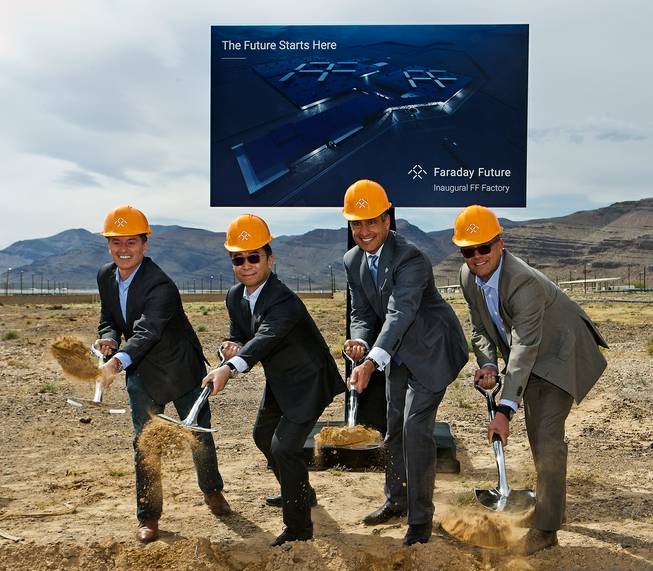
Tom Wessner of Faraday Future, Ding Lei of China’s LeEco, Gov. Brian Sandoval and Dag Reckhorn of Faraday Future throw the first shovels of dirt Wednesday, April 13, 2016, during the Faraday Future groundbreaking.
Wednesday, April 13, 2016 | 6:01 p.m.
Executives for electric car company Faraday Future, suppliers and politicians celebrated the official kickoff to construction on the company’s North Las Vegas manufacturing plant with a Champagne toast Wednesday afternoon. Gov. Brian Sandoval and North Las Vegas Mayor John Lee were among those to address the crowd inside a windowed tent at the site of the future factory surrounded by the vast, mostly empty desert expanses of Apex Industrial Park.
Little new information was revealed at the groundbreaking ceremony, but Faraday hinted at what might be in store for its future, highlighting progress it has made in attracting suppliers, plans for the factory and updates on its timeline to produce a production car within the next couple of years.
Faraday started clearing its land at Apex in late January and closed on its last two parcels of land at the site today, for a total of more than 900 acres. The company expects to begin grading the land, the next step in the construction process, sometime in the second quarter, according to Dag Reckhorn, Faraday’s vice president of manufacturing.
The factory will be a 3.4 million-square-foot facility, with large glass windows, solar panels and smart technology. Ding Lei, a top executive at LeEco, Faraday’s strategic partner, called it “the most advanced auto plant.” It will manufacture Faraday’s first production vehicle.
Faraday has yet to reveal the design of that car, which is likely to provide more clues about the company’s long-term goal to change transportation. Auto experts have been hesitant to make predictions about Faraday’s viability until they see what product the company plans to offer.
After the event, Faraday’s Vice President of Supply Chain Tom Wessner said designs for the interior and exterior have been completed for a year. Despite internal debate about whether to unveil the production car at CES, the company opted not to in an effort to build up hype.
“I think right now it’s actually the right strategy,” he said.
He compared Faraday to Apple, which generally unveils its products around the same time they hit the market. Faraday announced that it had made considerable progress laying the groundwork for manufacturing. Wessner said it has located 90 percent of its suppliers.
Government officials who helped lure the factory to North Las Vegas hoped suppliers would establish a presence in the region. Wessner said he has had discussions with suppliers about that possibility but that the companies have yet to make commitments. He said some suppliers will want to be close to the plant, including those who assemble seats and the undercarriage.
As the city’s mayor, Lee touted the day as a “ribbon cutting” for Apex Industrial Park, which has existed for decades but remained relatively empty, save a few scattered businesses across the park’s 18,000 acres.
“Today this desert gets its oasis,” said Lee, who worked with City Manager Qiong Liu and other city staff to put North Las Vegas on Faraday’s radar as it searched for a site for its manufacturing plant.
Sandoval stressed how Faraday fits into the idea of a “New Nevada” by contributing to education and workforce training across the state.
As part of a $215.9 million incentive package to bring Faraday to Nevada, the state Legislature passed a bill creating a workforce development program to train skilled employees for Faraday and other businesses. Faraday also has pledged to contribute $1 million a year to K-12 education in the state for six years.
“This is exactly what we planned for. We planned for success, to diversify and change our economy. Hyperloop, Tesla, drones, a partnership with NASA, autonomous vehicles — it wasn’t in our lexicon,” Sandoval said. “We’re creating the workforce of the future.”
Sandoval tied that into his tax package to boost funding for K-12 education in the state, adding that it “all fits together” in the idea of the “New Nevada.”
Not all state officials have been as optimistic in their assessments. State Treasurer Dan Schwartz has continued to raise doubts about Faraday over the past few months, questioning its financial wherewithal, despite legislative protections that cover the state’s investment if Faraday fails. Schwartz did not attend the groundbreaking, but a representative of his office participated.
Faraday’s only disclosed investor is is Jia Yueting, who leads LeEco, a Chinese media conglomerate formerly known as LeTV, though company officials say it has a diverse and global investment strategy. Unlike many new tech ventures that center around one leader, the California-based company with about 700 employees has not named a CEO. Top executives said they take a collaborative approach to management.
Stacy Morris, a spokesperson for the company, declined to discuss Jia’s role.
“As an investor, he of course has a say, but we don’t get into the specifics of our business operations,” she said.


Join the Discussion:
Check this out for a full explanation of our conversion to the LiveFyre commenting system and instructions on how to sign up for an account.
Full comments policy